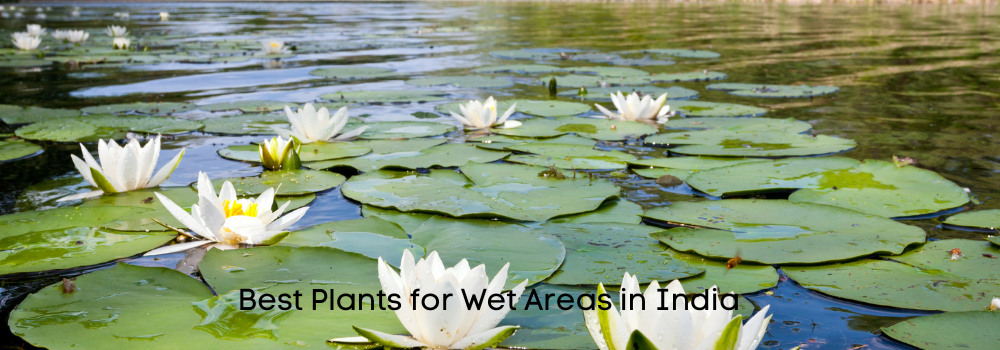
Best Plants for Wet Areas in India
1. Water Hyacinth (Eichhornia crassipes)
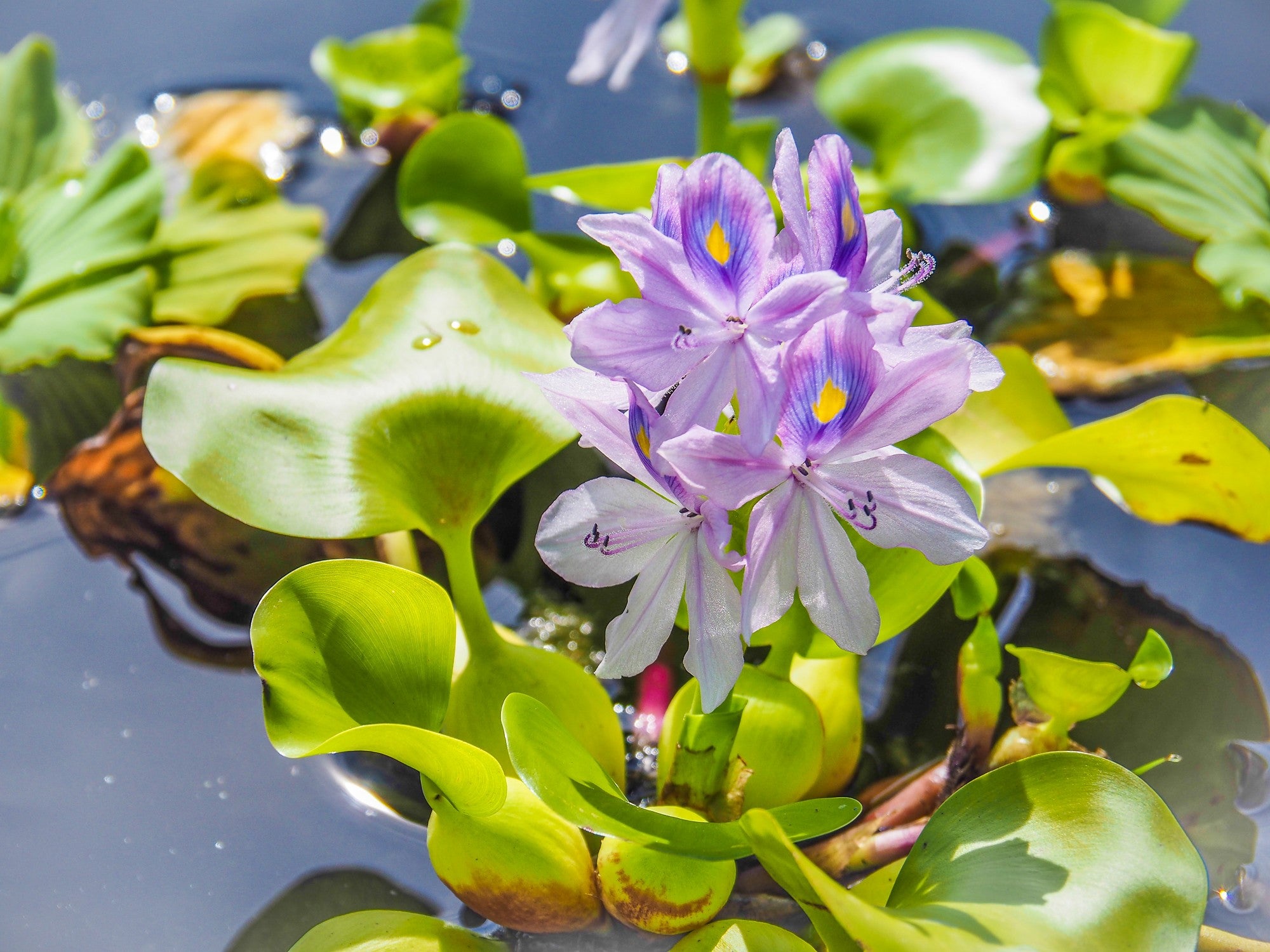
Eichhornia crassipes, commonly known as water hyacinth, is an aquatic plant native to the Amazon basin but has spread globally due to its ornamental value and rapid growth. Characterized by its thick, glossy green leaves and striking violet-blue flowers, water hyacinth floats on the surface of water bodies, thanks to bulbous air-filled sacs within its leaf stalks, which provide buoyancy. This plant can grow to about 0.4 to 1 meter in height.
Despite its beauty, water hyacinth is considered one of the most invasive aquatic plants. It proliferates quickly, forming dense mats on water surfaces, which significantly reduce water flow, block sunlight, and decrease oxygen levels in the water, negatively impacting aquatic life. Its rapid expansion can hinder boat navigation, affect fishing activities, and increase the risk of flooding.
Water hyacinth's adaptability to various water conditions, including those with high pollution levels, makes it a challenging invasive species to control. Methods such as manual removal, chemical herbicides, and biological control using specific insect species have been employed with varying degrees of success.
In some regions, water hyacinth is utilized for wastewater treatment, as it can absorb heavy metals and other pollutants. It's also explored for its potential in making furniture, handbags, and as a feedstock for biogas production due to its high cellulose content.
Efforts to manage water hyacinth infestations focus on preventing its spread, educating the public about its impacts, and employing integrated management strategies to control its growth. Conservationists and environmentalists emphasize the importance of balancing the ecological impacts of invasive species control with the preservation of natural habitats and biodiversity.
2. Indian Lotus (Nelumbo nucifera)
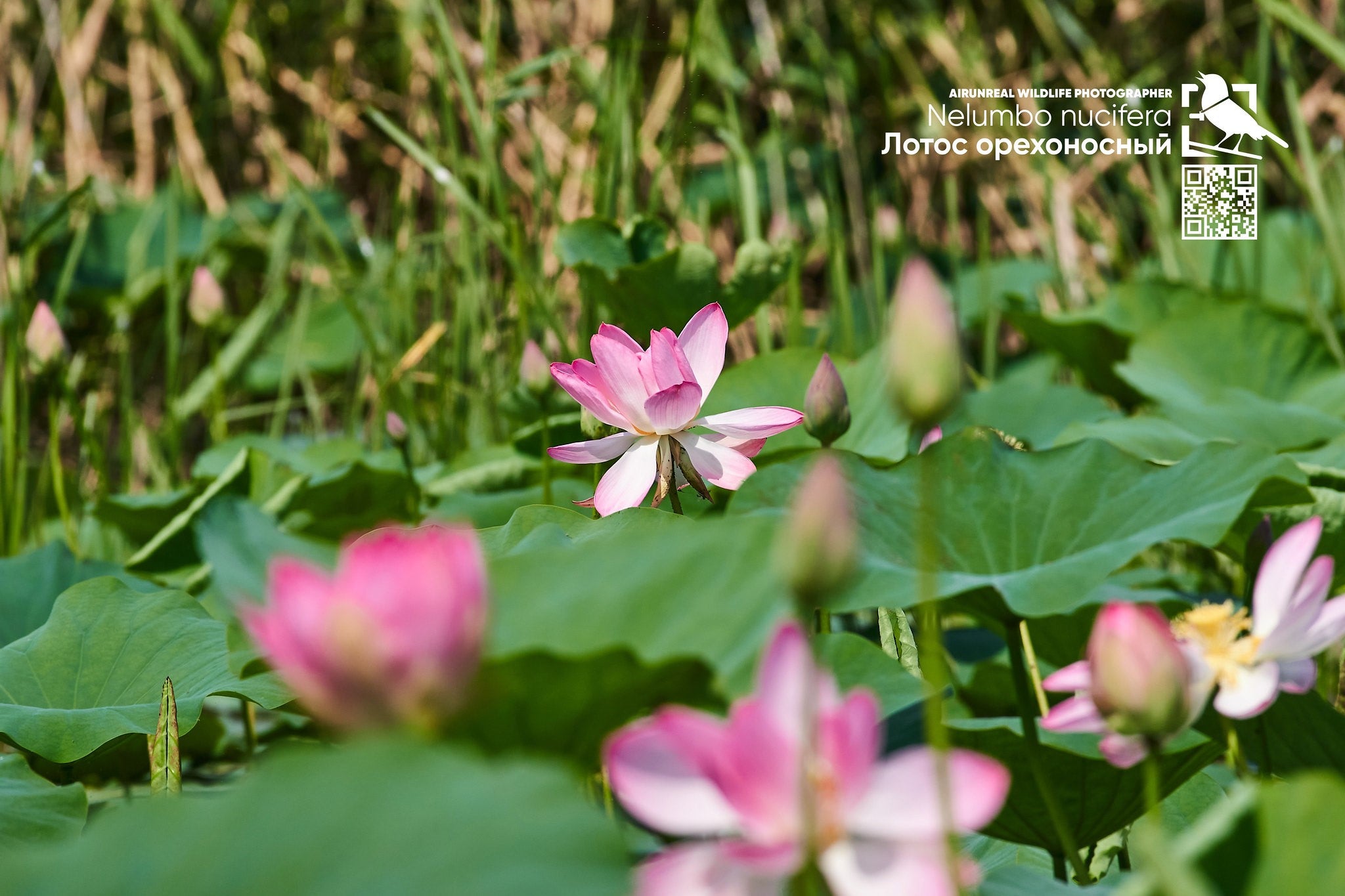
The Indian Lotus (Nelumbo nucifera), also known as the Sacred Lotus, is a revered aquatic plant deeply embedded in the cultural, religious, and artistic tapestry of India and other Asian countries. Symbolizing purity, beauty, eternity, and prosperity, it thrives in the calm waters of ponds, lakes, and slow-moving rivers across India, flourishing in muddy or silty bottoms.
Characterized by its distinctive, large, round leaves that float majestically on the water's surface, the Indian Lotus can reach up to 60 centimeters in diameter. These leaves are superhydrophobic, meaning they repel water, causing raindrops to bead and roll off, taking dirt with them, which keeps the leaves clean and healthy. The plant produces spectacular blooms that are pink or white, with a structure that is not only visually stunning but also intricately designed to promote efficient pollination. The flowers open in the morning and close at night, spanning up to 20 centimeters in diameter.
Lotus seeds, known for their longevity, can remain viable for centuries, symbolizing the plant's association with eternal life and resurrection themes. These seeds, along with the roots, leaves, and stems, play a significant role in Indian cuisine, offering a variety of health benefits and nutritional value. The roots, in particular, are used in salads, soups, and stir-fried dishes, appreciated for their crunchy texture and mild taste.
Cultivating the Indian Lotus requires full sunlight and a water depth ranging from 30 to 45 centimeters for optimal growth. They are not only cultivated for their aesthetic and symbolic significance but also for their edible parts, making them a versatile plant in both ornamental and agricultural contexts.
In landscaping and garden design, the Indian Lotus is often the centerpiece of water gardens and ponds, creating a serene and visually appealing environment. Its ability to purify water by absorbing pollutants further adds to its value, making it a vital component in the ecological balance of aquatic environments.
The Indian Lotus not only beautifies its surroundings but also serves as a symbol of spiritual enlightenment and rebirth, reminding us of the purity and resilience of nature amidst the murky waters it emerges from.
3. Canna Lily (Canna spp.)
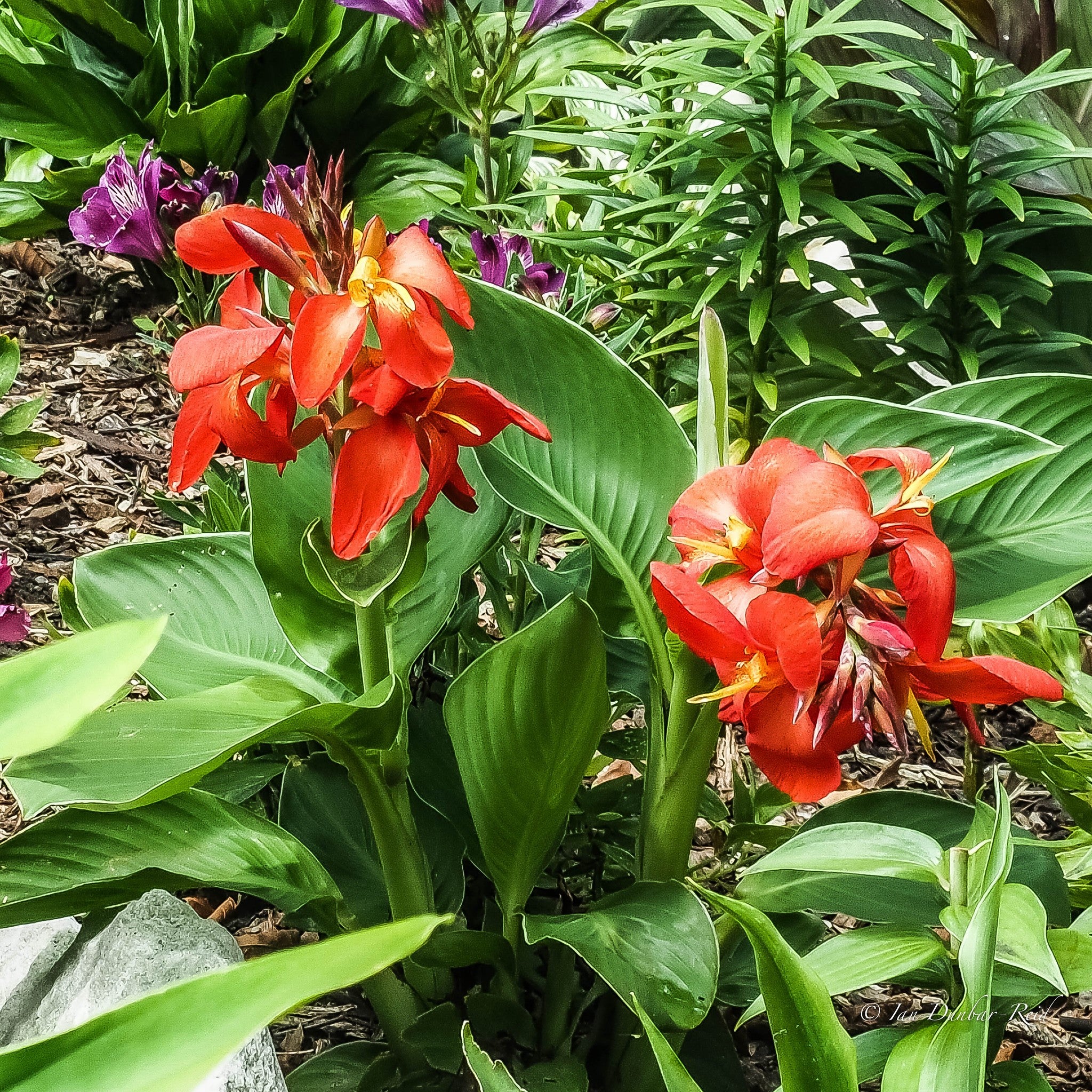
The Canna Lily (Canna spp.) is a vibrant and versatile perennial that thrives in both wet and well-drained soils, making it an excellent choice for gardeners in India looking to add color and texture to their landscapes. Originating from tropical and subtropical regions of the Americas, this plant is celebrated for its broad, banana-like leaves and large, showy flowers, which bloom in a range of colors from yellow and orange to red and pink.
Growing anywhere from 1.5 to 8 feet tall, depending on the variety, Canna Lilies can be planted as a striking focal point or used to create a lush, tropical effect in garden borders, wet areas, and even containers. They prefer full sun to partial shade and require regular watering, especially when planted in areas with less moisture. Cannas are not only ornamental but some species are also cultivated for their edible roots and foliage.
In terms of care, Cannas are relatively low maintenance. They benefit from a layer of mulch to retain moisture and control weeds. Fertilize them in the spring with a balanced, slow-release fertilizer to support vigorous growth and blooming. After the first frost in colder regions, the rhizomes can be dug up, cleaned, and stored in a cool, dry place over winter for replanting in the spring. In warmer climates, they can be left in the ground to regrow the following season.
Pests like the canna leaf roller and diseases such as rust and fungal leaf spot can affect Cannas. However, with proper care, including regular inspection and removal of affected parts, these issues can be managed effectively. Propagation is easily done by dividing rhizomes in spring.
Cannas have also played a role in hybridization efforts, leading to a wide variety of cultivars with improved flower colors, leaf variegations, and growth habits, offering gardeners numerous options for enhancing their garden aesthetics.
By integrating Canna Lilies into the garden, enthusiasts in India can enjoy a continuous display of flamboyant blooms and tropical foliage from late spring through the first frost, making them a popular choice for both novice and experienced gardeners alike.
4. Papyrus (Cyperus papyrus)
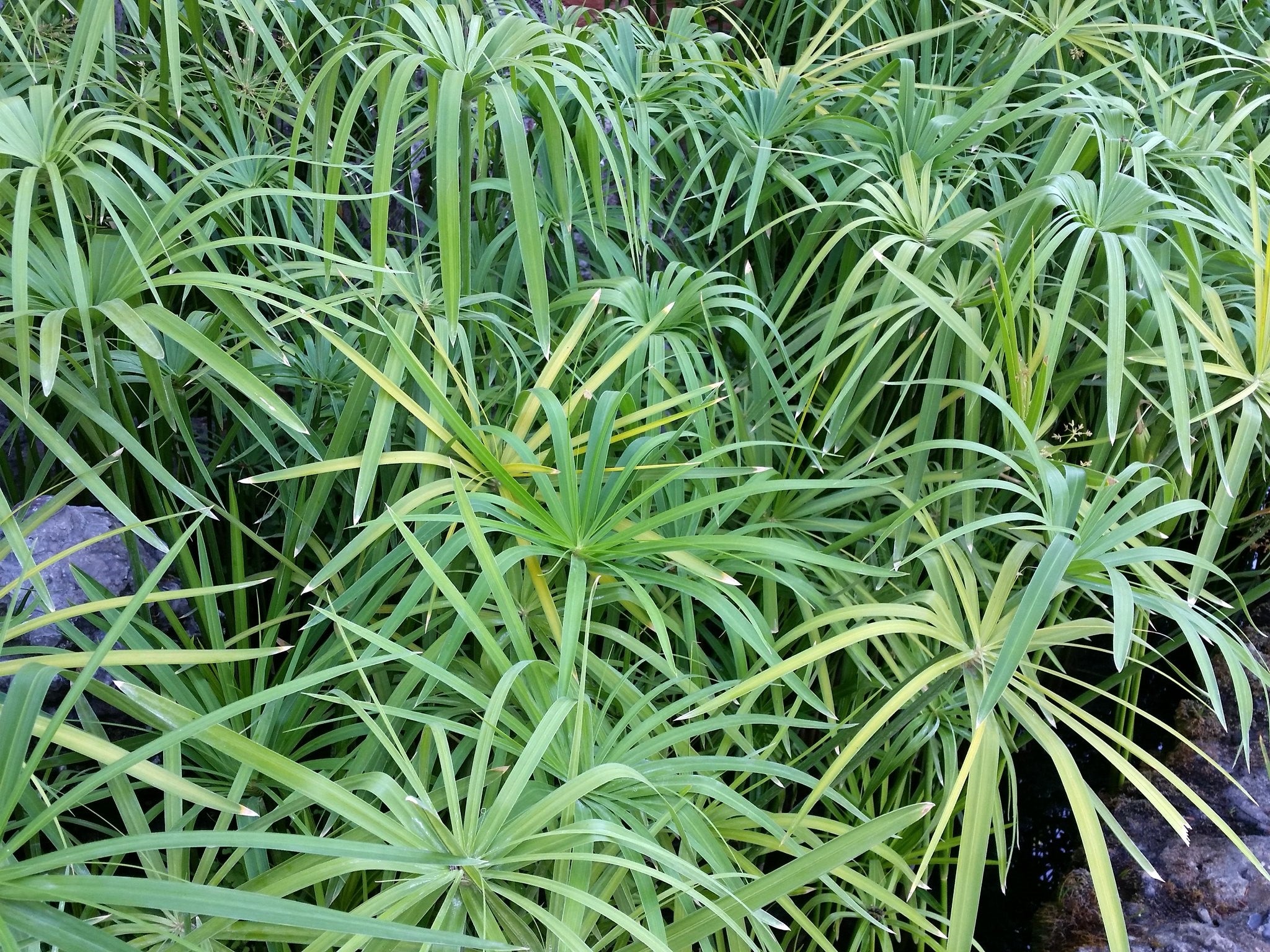
Papyrus (Cyperus papyrus) is an iconic aquatic plant, closely associated with the ancient Egyptian civilization, where it was famously used for making papyrus paper, boats, mats, and even as a food source. This tall, reed-like plant thrives in full sun and requires standing water to grow, making it ideal for ponds, water gardens, and wetlands. Its triangular stems can reach heights of up to 10 feet (3 meters) or more in optimal conditions, topped with a distinctive, umbrella-like cluster of thread-like rays around 12 inches (30 cm) in width.
Cyperus papyrus is not just a plant of historical importance; it is also valued in contemporary water gardening and landscape design for its architectural shape and the graceful texture it adds to water features. It provides an excellent habitat for wildlife, supporting ecosystems by offering shelter and breeding grounds for birds and aquatic life. In temperate regions, papyrus can be grown as an annual or in containers that are moved indoors during colder months, as it is not frost-tolerant.
Care for papyrus is relatively straightforward. It prefers a pH between 6.0 and 8.5 and thrives in nutrient-rich waters. Although it is an aquatic plant, it can also do well in moist, well-drained soil, making it versatile for different garden settings. Propagation is typically done by division, ensuring a quick and effective way to spread this exotic beauty in your garden space.
Papyrus plays a role not only in beautifying the landscape but also in purifying water, as it can absorb heavy metals and other pollutants, making it beneficial for maintaining the health of garden ponds and waterways. With its lush, green appearance and significant cultural history, Cyperus papyrus continues to be a popular choice for gardeners looking to add a touch of elegance and intrigue to their water gardens.
5. Water Lily (Nymphaea spp.)

Water Lilies (Nymphaea spp.) are emblematic aquatic plants that grace water bodies across the globe, including India, where they hold a special place in both natural and cultivated aquatic settings. Belonging to the family Nymphaeaceae, these perennial plants thrive in still or slow-moving waters of ponds, lakes, and garden water features. Their presence is not only aesthetically pleasing but also ecologically beneficial, providing habitats and shade that support diverse aquatic life.
The genus Nymphaea comprises a variety of species, each showcasing a range of colors from pure whites and delicate pinks to vibrant blues and deep purples. The flowers of water lilies are not only a feast for the eyes but are also renowned for their fragrant aroma, especially noticeable in the early morning and late afternoon. The floating leaves, or lily pads, are almost as iconic as the flowers themselves, providing a lush greenery that contrasts beautifully with the water's surface.
Cultivation of water lilies requires sun exposure for at least six hours a day and a calm, aquatic environment. They are typically grown from tubers planted in pots submerged in ponds or water gardens. The depth at which they are planted is crucial for their success; too deep and the lilies may not bloom, too shallow and the leaves might not spread across the water's surface adequately.
Water lilies are not only decorative but also serve a practical purpose in the aquatic garden. Their large leaves shade the water, helping to regulate temperature and reduce algae growth. Additionally, they provide a protective habitat for fish and other aquatic organisms, offering shelter from predators and the sun.
In terms of care, water lilies are relatively low maintenance once established. They require occasional fertilization for optimal growth and blooming. However, it's important to monitor for pests and diseases, such as lily beetles or fungal infections, which can mar the leaves and flowers.
Water lilies hold cultural significance in many parts of the world, symbolizing purity, beauty, and rebirth. In India, they are often associated with spiritual and philosophical themes, appearing in art, literature, and religious contexts.
In conclusion, Nymphaea spp. offer a blend of visual beauty, ecological benefits, and cultural significance, making them a cherished choice for water gardens in India and beyond. Their serene appearance and the tranquil ambiance they create are unmatched, providing a slice of paradise in any water feature.
6. Bamboo (Bambusoideae)
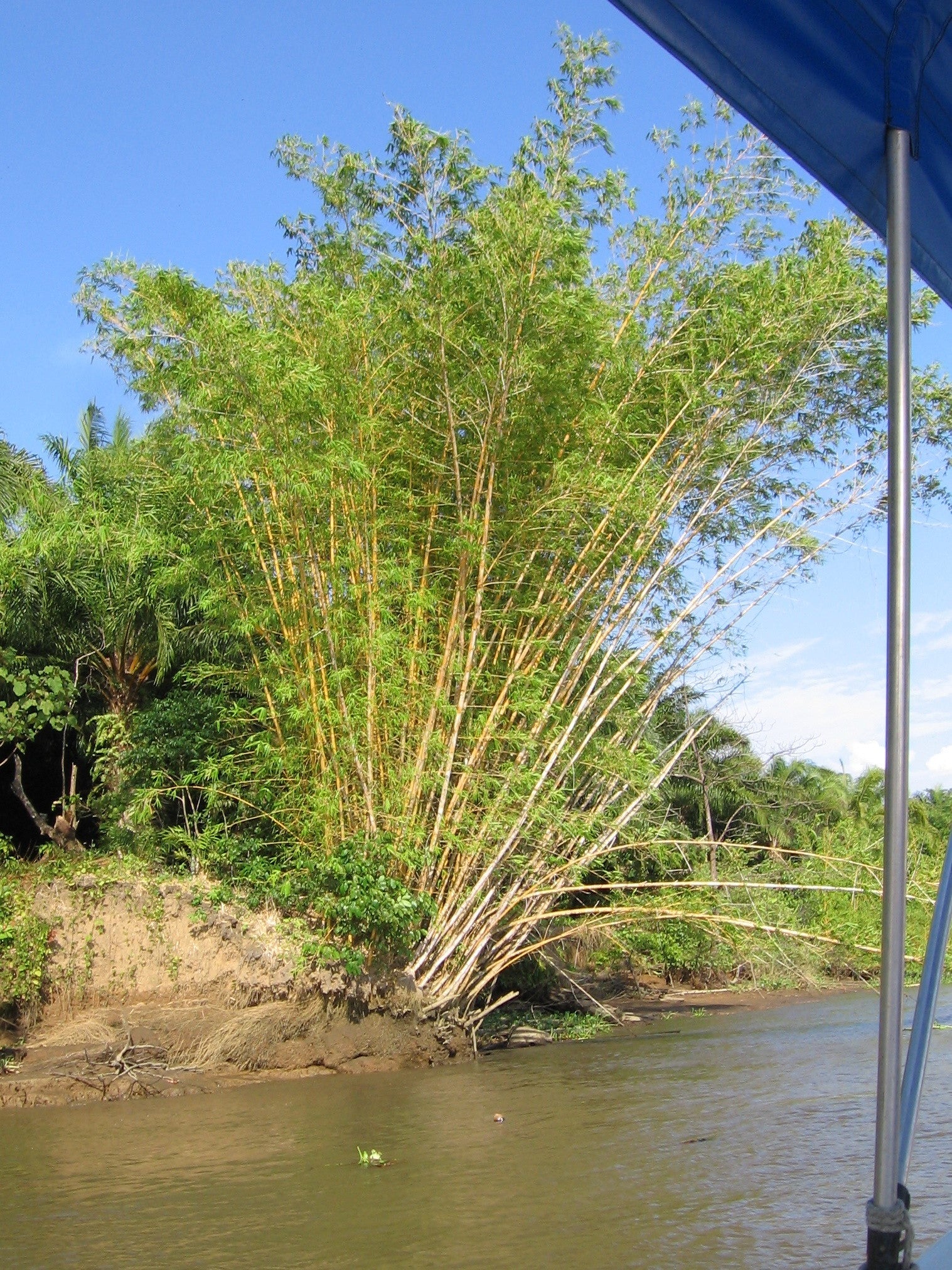
Bamboo, belonging to the Bambusoideae subfamily, represents one of the most versatile and rapidly growing plants in the world, with a presence across various climates but particularly flourishing in tropical and subtropical regions, including India. This plant is not just a symbol of resilience and longevity but also plays a crucial role in ecological balance, soil stabilization, and carbon sequestration, making it invaluable in efforts against climate change.
There are over 1,000 species of bamboo, varying in size from miniature plants to towering giants that can reach up to 30 meters (about 100 feet) in height. Bamboos are known for their fast growth, some species growing up to 91 cm (36 inches) within a 24-hour period under optimal conditions. This rapid growth, combined with a robust root system, makes bamboo an excellent choice for areas prone to soil erosion, including wet environments.
Bamboo's uses are as diverse as its species. It is widely employed in construction, furniture making, and crafts due to its strength and flexibility. In addition, bamboo shoots are an important food source in many Asian cuisines, offering nutritional benefits. Its fibers are used in making textiles and paper. Moreover, bamboo is increasingly recognized for its role in creating eco-friendly products, from clothing to utensils, signaling a shift towards sustainable living practices.
Cultivation of bamboo requires consideration of species-specific needs, generally involving well-drained soil, adequate moisture, and protection from extreme winds. Although some types prefer wet conditions, over-watering or poorly drained soil can lead to root rot. Bamboos can be propagated from seeds or more commonly through rhizome cuttings, offering a sustainable method to expand bamboo plantations or for home gardening.
In India, bamboo holds cultural significance and is integral to various traditional practices and festivals. The government and several organizations promote its cultivation for environmental conservation and as a means to boost rural economies through bamboo-based industries.
Environmental benefits aside, bamboo's aesthetic appeal cannot be overlooked. Its graceful form and the rustling sound of leaves in the breeze add a tranquil element to gardens and landscapes. Whether used as a privacy screen, a feature plant, or for erosion control in wet areas, bamboo offers a sustainable, fast-growing, and versatile solution.
In summary, Bamboo stands out as a plant of remarkable environmental, economic, and aesthetic value. Its role in traditional practices, coupled with its potential in modern sustainable industries, underscores its significance beyond just a plant, marking it as a vital resource for the future.
7. Swamp Hibiscus (Hibiscus coccineus)

The Swamp Hibiscus (Hibiscus coccineus), also known as the Scarlet Rosemallow or Texas Star, is a striking perennial plant native to the southeastern United States, including Florida, Georgia, and Alabama. It thrives in wet environments, such as swamps, marshes, and the edges of ponds and rivers, making it a splendid addition to water gardens or moist areas in Indian landscapes.
This species is renowned for its vibrant, scarlet-red flowers that bloom from early summer to late autumn, attracting a plethora of pollinators, including butterflies and hummingbirds, adding dynamism and color to gardens. The flowers, typically 6-8 inches in diameter, are composed of five distinct, pointed petals, emerging from tall, erect stems that can reach heights of 3-7 feet. The foliage of the Swamp Hibiscus is equally attractive, featuring lance-shaped, glossy green leaves that provide a lush backdrop for the dramatic flowers.
Cultivation of Swamp Hibiscus requires full sun to partial shade and consistently moist to wet soil conditions. It is relatively low-maintenance, although applying a layer of mulch can help retain soil moisture and reduce weed growth. In cooler climates, it can be treated as an annual or overwintered indoors to protect it from frost. This plant is generally resistant to pests and diseases, though it may occasionally be susceptible to aphids and whiteflies.
Swamp Hibiscus is not only valued for its ornamental appeal but also for its adaptability to wet soil conditions, making it an ideal choice for rain gardens, alongside water features, or in naturalized areas where it can spread and create stunning, red-flowered masses. Its ability to thrive in water-logged soils also makes it a practical solution for erosion control in damp regions.
In summary, the Swamp Hibiscus offers a spectacular display of red flowers that can enhance the biodiversity and aesthetic value of wet garden areas. Its ease of care, coupled with its environmental benefits, makes it a cherished plant for gardeners looking to add a touch of drama and natural beauty to their outdoor spaces.
8. Taro (Colocasia esculenta)
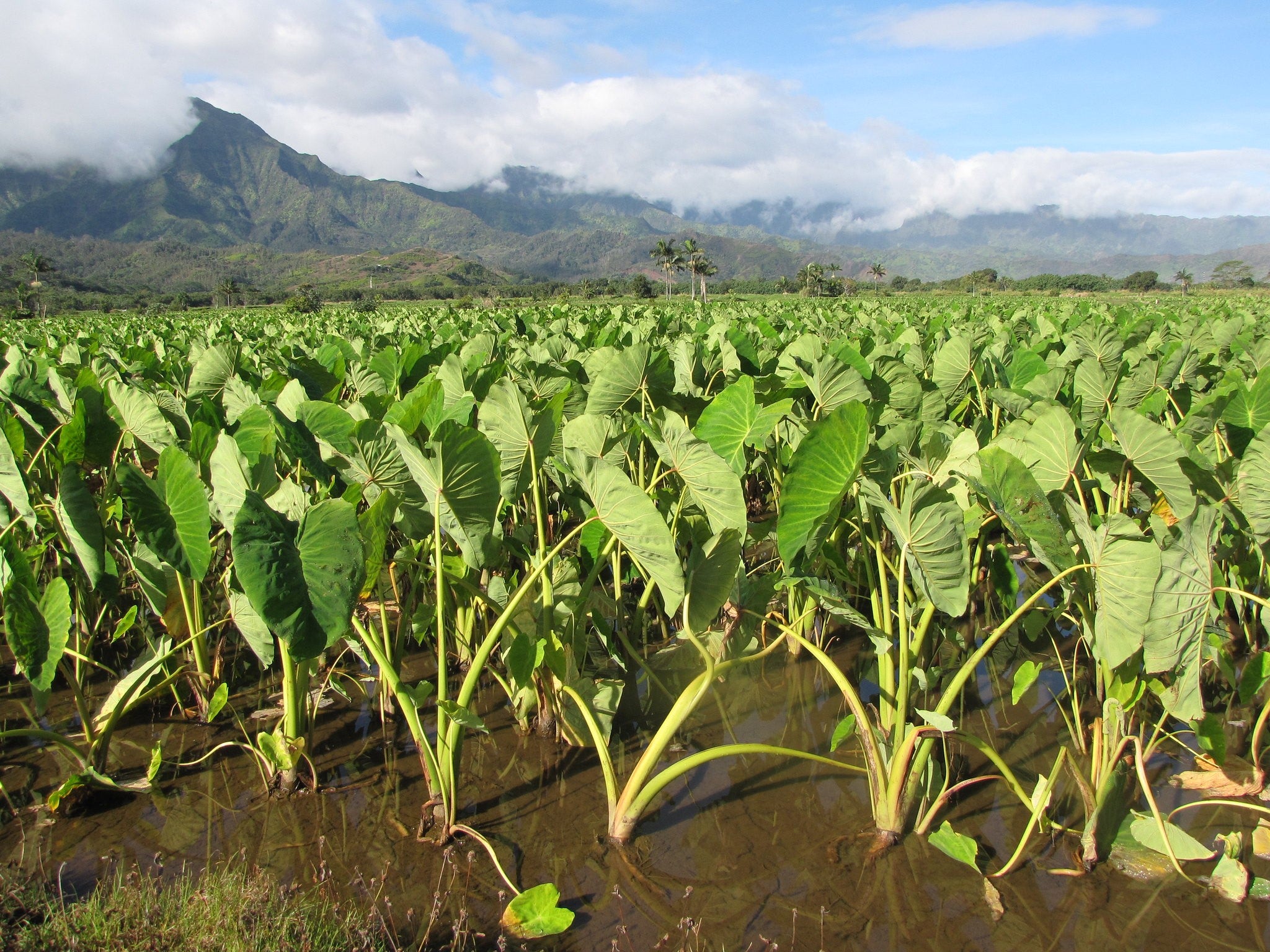
Taro (Colocasia esculenta) is a tropical plant cultivated primarily for its edible corms, a staple in various cuisines around the globe, notably in Asia, Africa, and the Pacific Islands. Its broad, beautiful leaves, resembling elephant ears, also make it a popular ornamental plant, adding a lush, tropical ambiance to gardens and water features.
Originating in Southeast Asia and India, taro has a long history of cultivation dating back thousands of years, making it one of the earliest cultivated plants. It thrives in humid, wet conditions, often grown in paddy fields or in water-logged soil, making it particularly suitable for areas with abundant water. Taro requires a warm climate to grow, with temperatures between 20°C to 30°C (68°F to 86°F) being ideal.
The plant features large, heart-shaped leaves that stand upright on long, sturdy stems. The corms, which grow underground, are the most valued part of the plant, rich in carbohydrates, fiber, and a good source of several vitamins and minerals, including vitamin E, vitamin B6, and manganese. They must be cooked before consumption to break down calcium oxalate crystals, which can cause irritation if ingested raw.
Taro has a nutty flavor, often compared to that of a sweet potato, and can be used in a variety of dishes, ranging from savory stews to sweet desserts. The leaves are also edible when cooked and are used similarly to spinach in many cultures.
In landscaping, taro is prized for its dramatic foliage and can be grown in water gardens, ponds, or damp soil in part to full shade. It's relatively easy to care for, requiring consistent moisture and regular fertilization to thrive. Taro can also be grown in containers, provided they are kept well-watered.
Pests and diseases can affect taro, including taro leaf blight, which can significantly impact leaf health and overall plant vigor. Regular monitoring and proper spacing to ensure good air circulation are key to preventing these issues.
Taro not only brings a taste of the tropics to the table but also enhances the garden with its striking foliage, embodying a perfect blend of utility and beauty. Whether grown for culinary purposes or as a decorative element, taro adds a touch of exotic elegance to any setting.
9. Rice Paddy Herb (Limnophila aromatica)
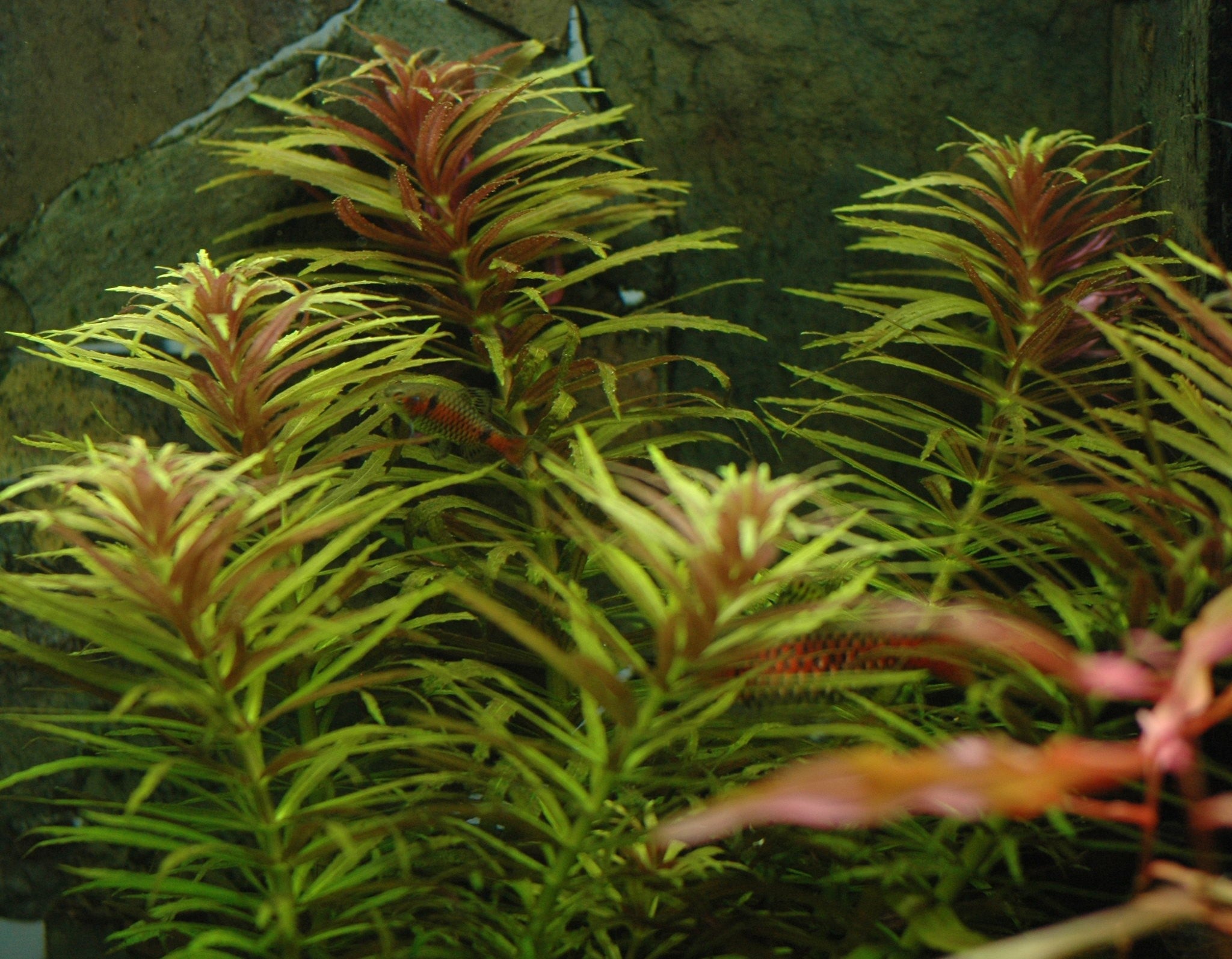
Rice Paddy Herb (Limnophila aromatica), also known as Vietnamese Mint or Rau Ôm, is a tropical plant native to Southeast Asia. It thrives in wet, flooded conditions, making it perfectly suited for rice paddies, hence its name. This herb is highly valued in Vietnamese cuisine for its unique lemony and floral flavor, often used in soups, salads, and seafood dishes. Limnophila aromatica is not just a culinary delight; it also serves an ornamental purpose in aquariums and water gardens due to its attractive, fine-textured foliage.
The plant prefers full sun to partial shade and requires a consistently moist or submerged environment to flourish. It can grow in water up to several inches deep, making it an excellent choice for the edges of ponds or in aquatic gardens. In terms of care, Rice Paddy Herb is relatively low maintenance. It benefits from regular trimming to encourage bushier growth and to prevent it from becoming too leggy. Propagation is easily achieved through stem cuttings, which root readily in water.
Apart from its culinary uses, Rice Paddy Herb is believed to have medicinal properties. In traditional medicine, it has been used to treat skin conditions and as a cooling herb to reduce fever.
Its adaptability to wet environments and minimal care requirements, combined with its culinary and aesthetic appeal, make Limnophila aromatica a cherished plant in the regions it grows. Whether for its flavor in cooking, its beauty in water gardens, or potential health benefits, Rice Paddy Herb is a versatile addition to any wet soil or aquatic setting.
Given its tropical nature, in cooler climates, it's often grown as an annual or in greenhouses where conditions can be controlled. This allows enthusiasts worldwide to enjoy the beauty and taste of this unique herb, even if they're far from its native habitat.
10. Marsh Marigold (Caltha palustris)

Marsh Marigold (Caltha palustris), also known as kingcup, is a vibrant perennial plant that thrives in wet, marshy environments, such as the edges of ponds, streams, and in wet woodlands. This plant is native to temperate regions of the Northern Hemisphere, including parts of India, where it's cherished for its early spring blooms. Marsh Marigold belongs to the buttercup family, Ranunculaceae, and is recognized for its glossy, heart-shaped leaves and bright yellow, cup-shaped flowers that appear in early spring, often as one of the first signs of spring in wetlands.
Growing to about 30-60 cm in height, Marsh Marigold prefers full sun to partial shade and loves rich, muddy soils that are constantly moist or submerged in shallow water. It's an excellent choice for naturalizing in bog gardens, pond margins, and other wet areas, offering a splash of color when few other plants are flowering. Besides its ornamental value, it provides essential early-season nectar for pollinators like bees and butterflies.
While Marsh Marigold is easy to grow and requires little maintenance once established, it's important to ensure the soil doesn't dry out, especially during hot, dry periods. No significant pests or diseases commonly afflict it, making it a robust and reliable plant for suitable environments. Propagation can be achieved through seed sowing in autumn or by division in early spring or fall. When handling the plant, it's essential to wear gloves as its sap can irritate the skin.
Marsh Marigold's lush foliage and golden blooms make it a standout addition to any water garden or wetland setting, adding beauty and supporting local wildlife. It's a testament to the unique charm and ecological benefits of native plants, encouraging biodiversity and offering a stunning visual display in the garden.
11. Rain Lily (Zephyranthes spp.)

Rain Lily (Zephyranthes spp.), commonly referred to as fairy lily or Zephyr lily, is a charming and resilient flowering plant ideal for adding splashes of color to gardens, especially in wet areas. Belonging to the Amaryllidaceae family, this perennial is native to the Americas and is particularly suited to regions with a warm climate, including various parts of India.
Appearance: Rain Lilies are known for their delicate, trumpet-shaped flowers, which bloom in a variety of hues such as white, yellow, pink, and orange. The flowers emerge on slender stems above grass-like foliage, creating a whimsical, airy appearance. Each bloom lasts just a few days, but the plants often produce flowers in succession, especially after rain, hence the name.
Cultivation: They thrive in full sun to partial shade and prefer well-drained soil. Although tolerant of dry conditions, Rain Lilies perform best when they receive consistent moisture, particularly during the blooming period. They are often planted in clusters or masses for an eye-catching display and can also be grown in containers where their beauty can be appreciated up close.
Care: Rain Lily care is minimal, making them an excellent choice for gardeners seeking low-maintenance plants. They require occasional watering during dry periods and benefit from a light application of fertilizer in spring. After blooming, it's important to allow the foliage to remain in place, as it gathers energy for the next flowering season.
Propagation: Propagation is usually done through dividing clumps of bulbs, ideally after the flowering period. This not only helps to proliferate your Rain Lily collection but also encourages healthier growth by preventing overcrowding.
Landscaping Use: With their compact size and attractive foliage, Rain Lilies are perfect for borders, rock gardens, and along pathways. Their post-rain flowering habit provides a delightful surprise, enlivening the landscape with bursts of color when least expected.
Ecological Benefits: Besides their aesthetic appeal, Rain Lilies attract pollinators such as bees and butterflies, contributing to the health of your garden's ecosystem.
In summary, Rain Lilies offer a combination of beauty, resilience, and ease of care that makes them a valuable addition to any garden, particularly those with wet areas. Their ability to burst into bloom after rain showers adds a dynamic element to the garden, providing joy and color when it's most appreciated.
12. Pickerel Weed (Pontederia cordata)
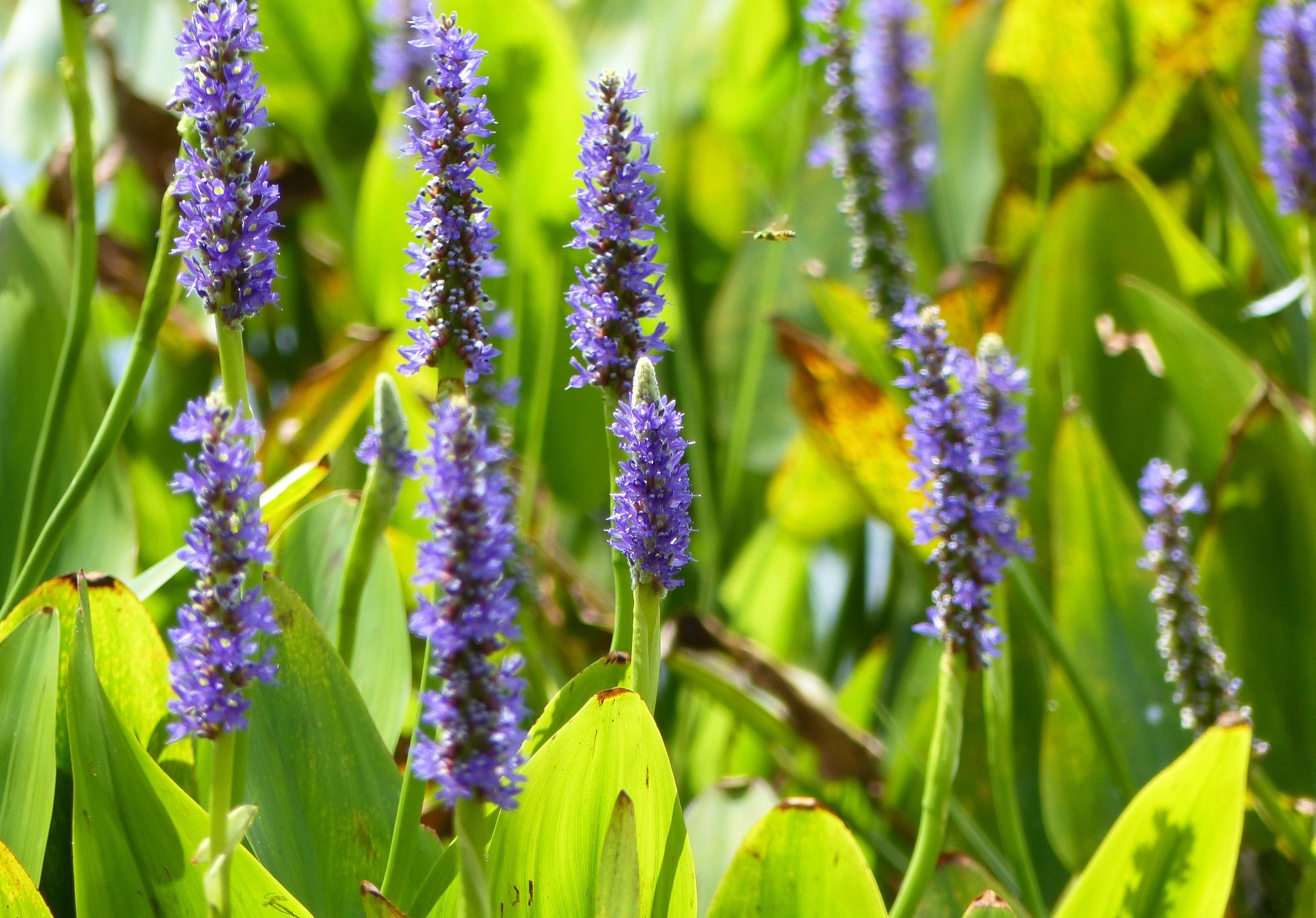
Pickerel Weed (Pontederia cordata) is an aquatic plant native to the Americas but has adapted to various climates around the world, including India. Thriving in shallow waters of ponds, lakes, and slow-moving streams, it is a perennial that adds beauty and ecological value to water gardens and natural wetlands.
Characterized by its glossy, heart-shaped leaves and striking spikes of blue to violet flowers, Pickerel Weed blooms from late spring through summer. The flowers, arranged in a dense spike, are highly attractive to pollinators such as bees and butterflies, making it an essential plant for biodiversity. This plant typically reaches a height of 2 to 4 feet, depending on the depth of the water it grows in and the richness of the soil.
Pickerel Weed is not only valued for its aesthetic appeal but also for its contribution to the ecosystem. It acts as a biofilter, helping to purify water by absorbing excess nutrients and providing oxygenation. Furthermore, its dense foliage offers shelter and breeding grounds for aquatic wildlife, including fish and amphibians.
Cultivation of Pickerel Weed is straightforward. It prefers full to partial sun and thrives in muddy or shallow, standing water, making it ideal for pond margins or water features in gardens. It is propagated by dividing the rhizomes in early spring or by seed. Once established, Pickerel Weed requires minimal maintenance, though it can be pruned to control growth and remove spent flower spikes to encourage more blooms.
Pickerel Weed is hardy in USDA zones 3 through 10, showcasing its adaptability to a wide range of climates. Its resilience and low maintenance make it a popular choice for both ornamental water gardens and natural wetland restoration projects.
In landscaping, Pickerel Weed can be paired with other water-loving plants such as Water Lilies (Nymphaea spp.), Iris, and Cattails (Typha spp.) to create diverse, attractive aquatic environments. Its ability to attract wildlife and contribute to water quality makes it a valuable addition to any garden or conservation area focusing on sustainable, native planting.
Overall, Pickerel Weed (Pontederia cordata) is a versatile, ecologically beneficial plant that enhances the beauty and health of aquatic environments. Its ease of care, combined with its environmental benefits, makes it a must-have for water garden enthusiasts and conservationists alike.
13. Japanese Iris (Iris ensata)

The Japanese Iris (Iris ensata), also known as the Japanese Water Iris, stands out as one of the most splendid species in the Iris family, celebrated for its large, lavish flowers and elegant stature. Originating from Japan, this perennial is highly valued in water gardens and moist areas, where its striking blooms make a dramatic statement from late spring to early summer.
Iris ensata thrives in full sun to partial shade and prefers acidic, rich, moist, well-drained soil. It's unique in that it requires abundant water during the growing season, especially when blooming, making it ideal for pond edges, water gardens, or other wet environments. The plant can reach up to 4 feet in height, offering a variety of colors including shades of purple, blue, white, and pink, with intricate veining and patterns that add to its beauty.
Cultivation involves planting in early spring or fall, ensuring the rhizomes are slightly exposed above the soil to prevent rot. Regular watering, mulching, and removing spent flowers promote healthy growth and encourage reblooming. It's relatively disease-resistant but can be prone to iris borer and root rot if conditions are too wet.
Japanese Iris has been cultivated for centuries in Japan, where it's celebrated for its elegance and beauty. It's not just a garden plant; it's a symbol of purity and bravery. Numerous cultivars offer gardeners a range of sizes, colors, and forms, making it a versatile choice for adding dramatic flair to garden landscapes.
For enthusiasts looking to add this exotic beauty to their gardens, it's essential to source plants from reputable nurseries and consider companions like ferns and astilbes that enjoy similar conditions. Iris ensata is a testament to the diversity and beauty of the Iris genus, offering a spectacular display that enchants gardeners and nature lovers alike.
14. Bog Sage (Salvia uliginosa)
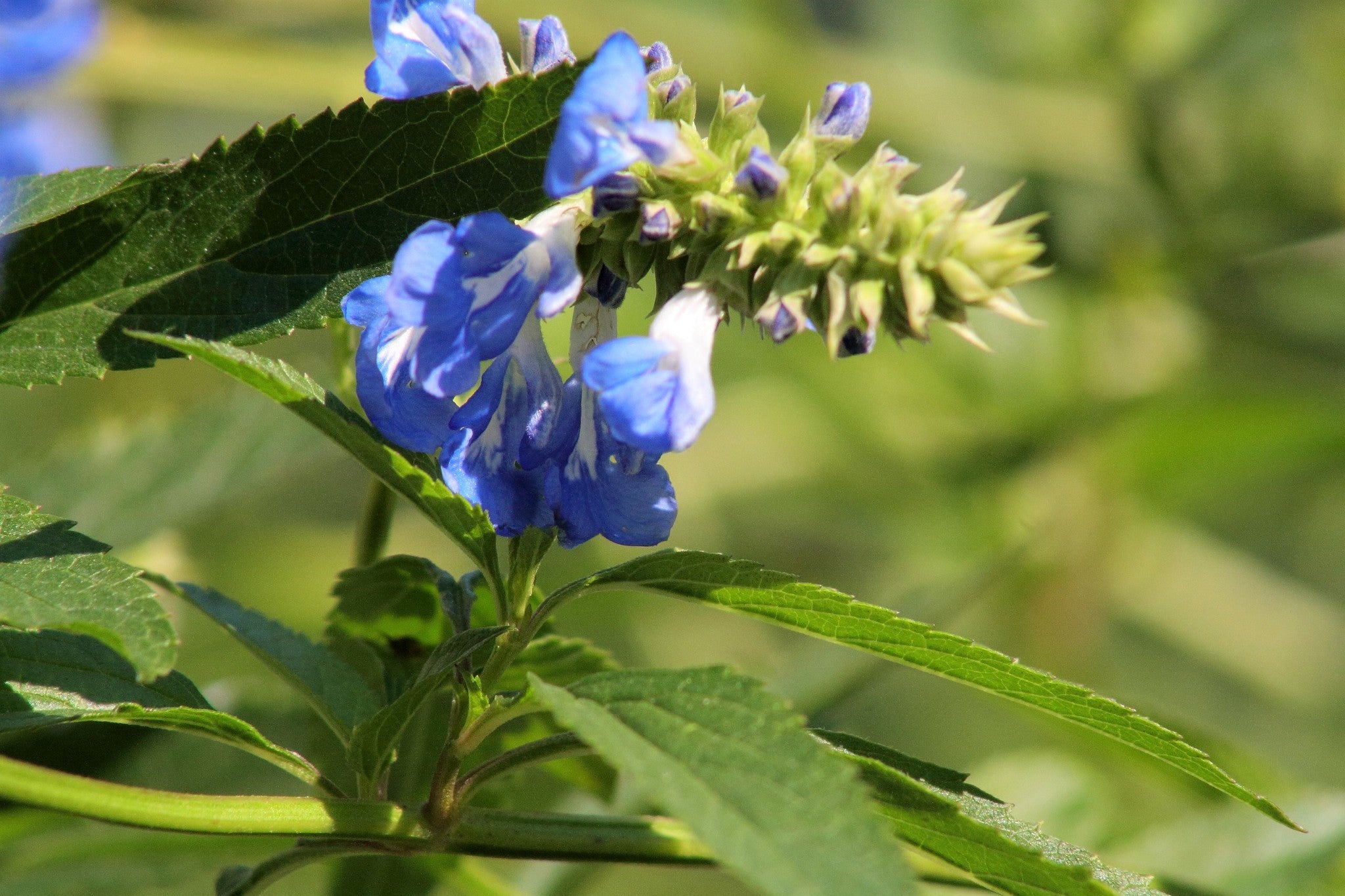
Bog Sage (Salvia uliginosa), also known as the blue spike sage, is a perennial plant native to South America, specifically Argentina, Brazil, and Uruguay. This plant is renowned for its striking sky-blue flowers and its affinity for moist, wet conditions, making it an ideal addition to water gardens, bog gardens, or alongside ponds and streams. Growing typically to heights between 4 to 6 feet, Bog Sage features slender, airy stems clad with narrow, lance-shaped, light green leaves that can reach up to 4 inches long.
Flowering from late summer into the fall, it provides a late-season nectar source for bees, butterflies, and other pollinators, playing a crucial role in the ecosystem by supporting biodiversity. The blooms are tubular and vivid blue, arranged in whorls along the upper part of the stems, creating a visually appealing display against the foliage.
Cultivation of Bog Sage requires full sun to partial shade, with the plant performing best in rich, well-draining soil that remains consistently moist. While it thrives in wet conditions, it's surprisingly drought-tolerant once established, making it versatile for various garden settings. In colder climates, it may die back in winter but will return in spring if the roots are well-mulched and protected from freezing.
Propagation is typically achieved through division or stem cuttings in spring. Regular deadheading of spent flowers can encourage a longer blooming period and prevent the plant from becoming too leggy. Bog Sage is relatively low maintenance but can benefit from staking in windy areas due to its height and slender stems.
Including Bog Sage in your garden not only adds a splash of color with its enchanting blue flowers but also promotes wildlife presence, enhancing the garden's ecological value. Its tall, elegant stature makes it an excellent background plant for water features or as part of a mixed border, providing height and texture contrast.
While Salvia uliginosa is generally resistant to pests and diseases, it's important to provide adequate space for air circulation to prevent fungal issues in humid climates. With its ease of care, resilience, and stunning visual appeal, Bog Sage is a worthwhile addition to any garden seeking to incorporate water-loving plants or to attract more pollinators.
15. Horsetail (Equisetum hyemale)

Horsetail (Equisetum hyemale), also known as scouring rush, is a perennial fern that belongs to the ancient Equisetaceae family, tracing back over 400 million years. This plant is unique, not just for its long evolutionary history, but for its striking architectural appearance, which adds texture and interest to garden designs, especially in wet areas or water gardens.
Equisetum hyemale grows in erect, green, bamboo-like segments, reaching heights of 2 to 4 feet. The stems are jointed, with a rough, ribbed texture that historically lent itself to use as a natural abrasive or scouring tool. Horsetail prefers full to partial sun and thrives in wet, marshy conditions, making it an excellent choice for planting alongside ponds, streams, or in bog gardens. Its preference for moist soil does not limit its hardiness; it is remarkably resilient and can tolerate a range of soil types, provided the ground remains consistently moist.
Propagation is generally through division or spores, but it's worth noting that horsetail can be invasive in favorable conditions. Its root system is extensive and can spread rapidly, making it challenging to remove once established. Therefore, it's often recommended to plant Equisetum hyemale in containers or areas where its growth can be controlled.
Despite its invasive potential, horsetail has several benefits. It is known for its ability to absorb heavy metals from the soil, making it a useful plant for phytoremediation projects. Additionally, its structural form and simple, yet elegant appearance make it a favored plant for contemporary garden designs, where its vertical lines can be used to great effect.
In terms of care, Equisetum hyemale is low-maintenance. It requires little more than regular watering to ensure the soil does not dry out. No significant pests or diseases typically afflict it, making it a robust and enduring addition to suitable garden settings.
In summary, Horsetail is a fascinating and attractive plant for wet garden areas, valued for both its aesthetic appeal and its environmental benefits. Its care and propagation are straightforward, making it accessible to gardeners of all levels, provided measures are taken to control its spread.
16. Umbrella Plant (Cyperus alternifolius)
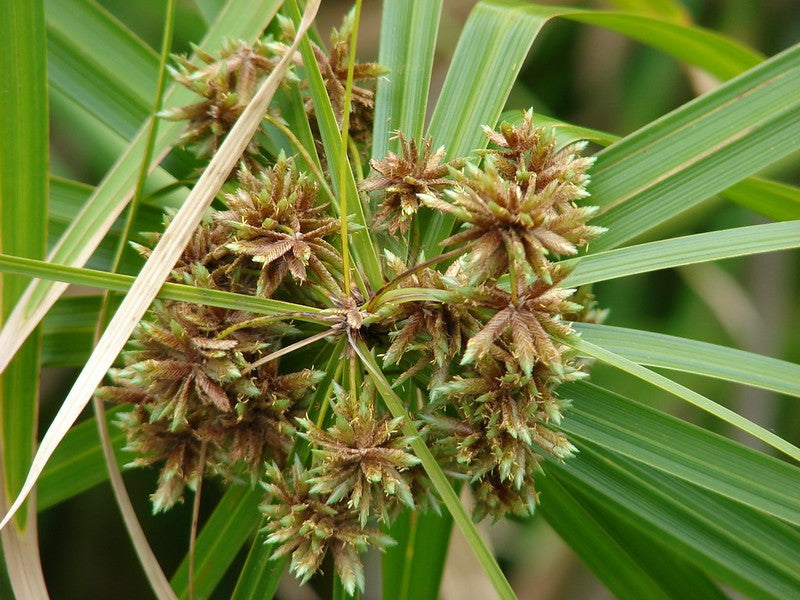
The Umbrella Plant, scientifically known as Cyperus alternifolius, is a distinctive and elegant aquatic plant native to Madagascar. Often found gracing water gardens, pond margins, and indoor water features, it is celebrated for its unique appearance and ease of care. This plant features long, slender stems that can reach heights of up to 6 feet in optimal outdoor conditions, though it usually remains smaller when grown indoors. Atop these stems, radiating like the spokes of an umbrella, are whorls of slender, green leaf-like structures called bracts, which give the plant its common name.
Thriving in full sun to partial shade, the Umbrella Plant prefers consistently moist or even shallow, standing water, making it an ideal choice for water gardens or as a naturally elegant indoor plant when placed in water-filled containers. It is not frost-tolerant and should be grown as an annual or brought indoors in regions where temperatures drop below freezing.
Propagation of the Umbrella Plant is straightforward, often done through division or by planting the seeds that form on the plant after flowering. While it's rarely bothered by pests or diseases, it's important to monitor for common houseplant pests if grown indoors.
This plant is not only valued for its decorative appeal but also for its ability to improve water quality by absorbing nutrients and providing a habitat for aquatic wildlife. Its carefree growth habit, requiring minimal maintenance aside from ensuring it has enough water, makes it a popular choice among both seasoned gardeners and novices. Whether incorporated into a serene garden pond, displayed in a large vase indoors, or used in a rain garden, the Umbrella Plant adds a touch of tropical elegance and an architectural element to any setting it graces.
17. Elephant Ear (Alocasia spp.)
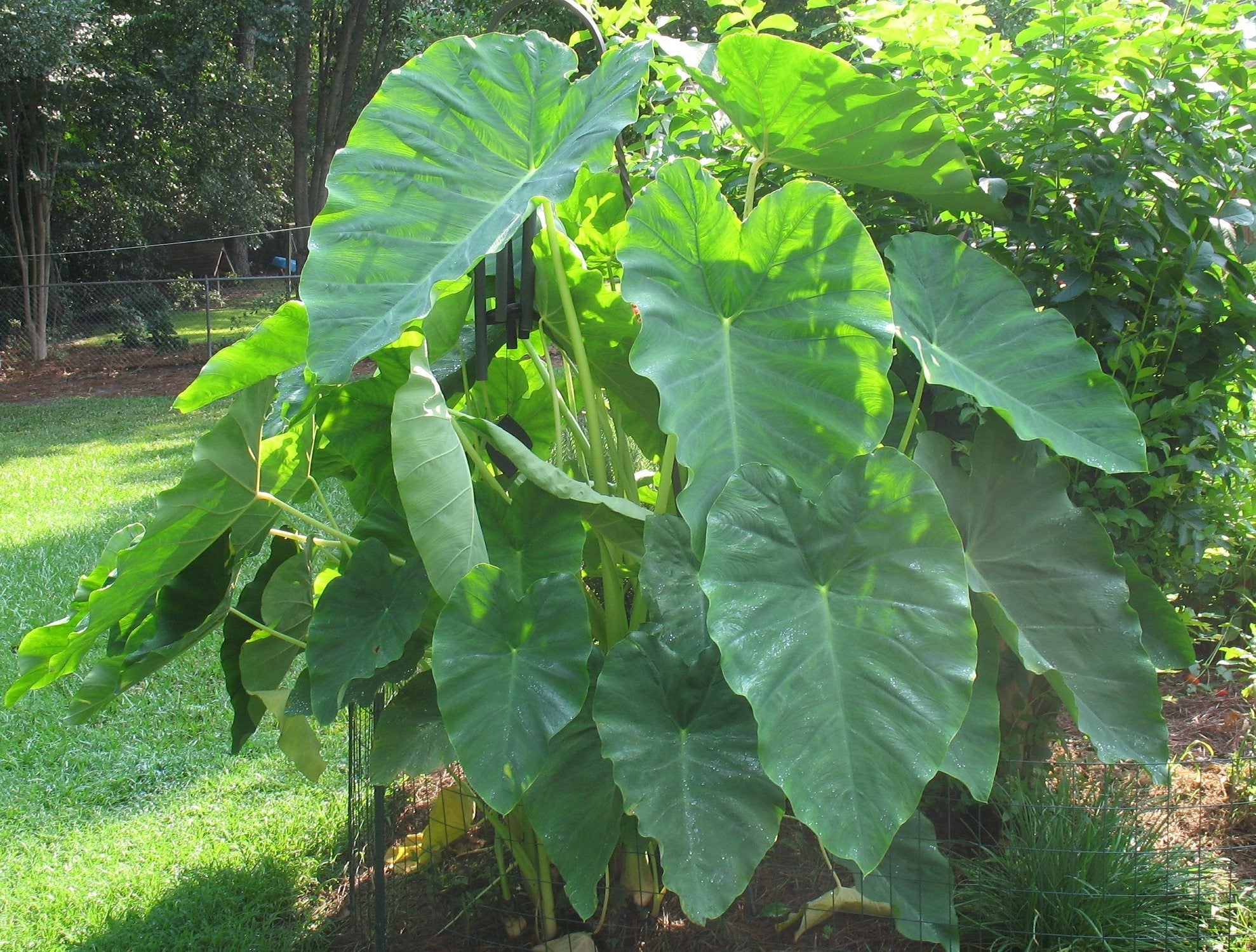
Elephant Ear (Alocasia spp.) is a group of perennial plants famed for their dramatic foliage, which resembles an elephant's ear in size and shape. Native to tropical and subtropical Asia to Eastern Australia, these plants thrive in warm, humid environments and are widely cultivated in gardens and homes worldwide for their striking appearance.
Characteristics: Alocasia plants can vary significantly in size, from small, desk-friendly varieties to those that reach several feet in height. Their leaves are their most notable feature, large, glossy, and often arrow or heart-shaped, coming in shades of green, sometimes with striking veins or contrasting colors. Some species also boast variegated or colored foliage, adding to their appeal.
Growing Conditions: Alocasia prefers bright, indirect light but can tolerate lower light levels. They require moist, well-draining soil and high humidity, making them suitable for bathrooms or kitchens. Over-watering can lead to root rot, so it's crucial to let the top inch of soil dry out between waterings. These plants are not cold-hardy and should be protected from temperatures below 15°C (59°F).
Care Tips: Fertilize Alocasia every two to three weeks during the growing season with a balanced, water-soluble fertilizer. They benefit from regular misting or a pebble tray to increase humidity. Pruning is rarely needed but remove any yellowing or damaged leaves to keep the plant healthy.
Propagation: Alocasia can be propagated through division of the rhizome or from offsets that form at the base of the plant, typically during repotting.
Pests and Problems: Watch out for common pests like spider mites, aphids, and mealybugs. Regularly inspect your plant and treat with insecticidal soap or neem oil if pests are detected. Leaf yellowing may indicate over-watering or poor drainage.
Uses: With their exotic look, Alocasia plants are perfect for adding a touch of the tropics to indoor spaces or shaded, humid outdoor gardens. They make stunning focal points in container gardens, terrariums, or as standalone specimens.
Alocasia plants require attention to thrive but reward the effort with their stunning foliage, making them a popular choice for gardeners and indoor plant enthusiasts looking for a touch of the dramatic in their plant collections.
18. Louisiana Iris (Iris fulva)
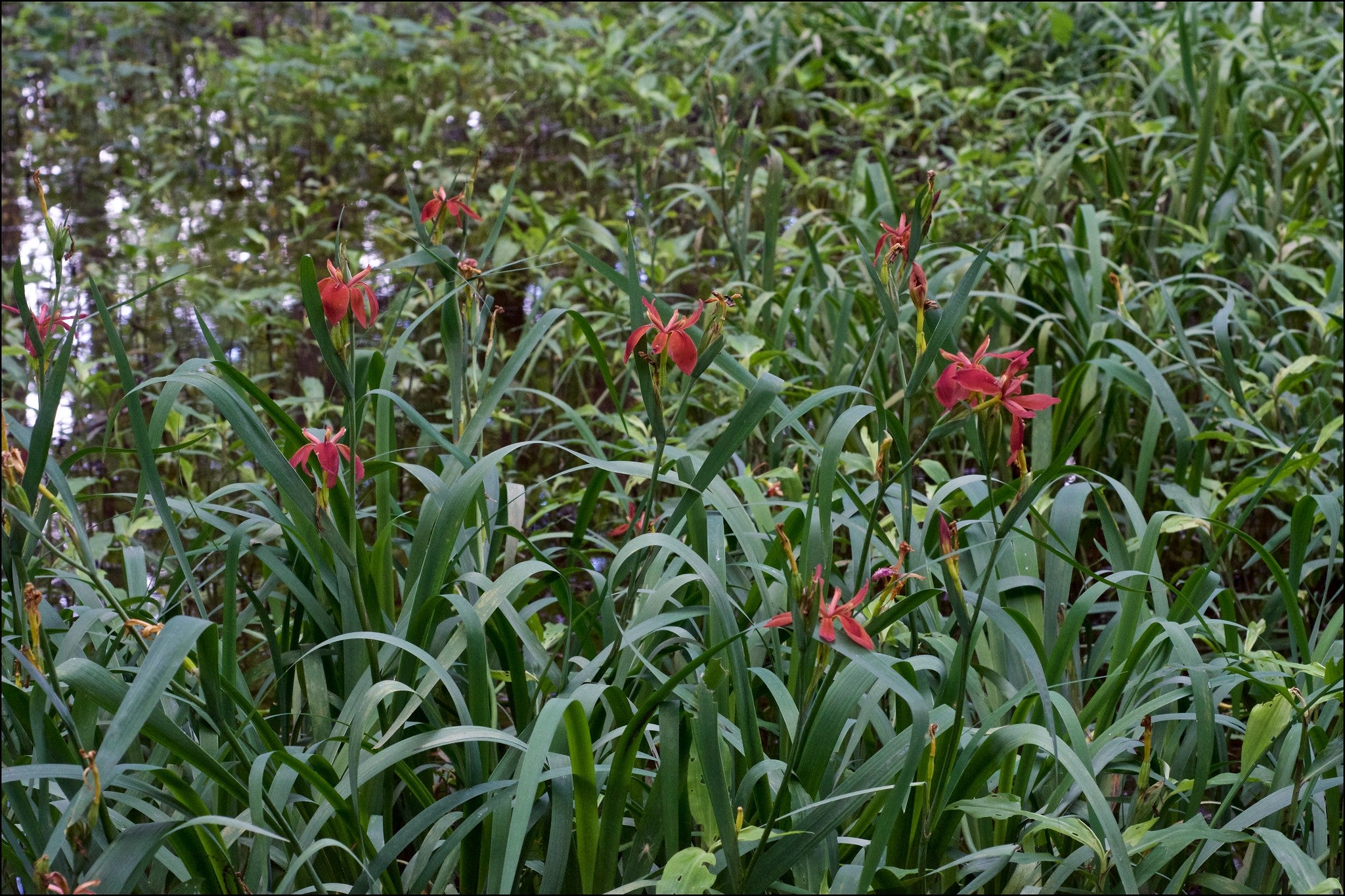
The Louisiana Iris (Iris fulva), also known as the copper iris, is a striking perennial that is native to the southeastern United States, including Louisiana's coastal swamps and wetlands. It is celebrated for its unique copper-colored flowers, although the blooms can also present shades ranging from red, orange, to brown, and even lavender, depending on the variety. This iris typically flowers in late spring to early summer, offering a vibrant display of color that can enhance any garden setting, especially those with moist soil or near water features.
Louisiana Iris thrives in USDA hardiness zones 5 through 9, making it a versatile addition to a variety of garden climates. It prefers full sun to partial shade and loves wet conditions, making it perfect for planting along pond edges, in rain gardens, or in naturally soggy areas of the garden. However, with the right care, it can also adapt to regular garden soil, as long as it is kept consistently moist.
One of the most appealing aspects of the Louisiana Iris is its ease of care. It requires minimal maintenance once established, other than ensuring it has enough water and the occasional division every few years to prevent overcrowding and promote healthy growth. Fertilization with a balanced, slow-release fertilizer in early spring can encourage more vigorous blooms. Moreover, it's relatively disease and pest-resistant, although gardeners should watch for the occasional iris borer or fungal issues in overly humid conditions.
The Louisiana Iris is not just a beautiful addition to gardens; it's also an important plant for biodiversity, providing habitat and food for pollinators and other wildlife. Its large flowers are particularly attractive to bees and hummingbirds, adding to the ecological value of your garden.
When planting Louisiana Iris, consider grouping them for a dramatic effect, or mix them with other water-loving plants for a diverse, attractive wetland garden area. Their tolerance for standing water also makes them an excellent choice for solving landscaping problems in wet areas where other plants might struggle.
In summary, the Louisiana Iris (Iris fulva) is a highly adaptable, low-maintenance plant that can add a splash of color to wet garden areas. Its unique flowers and ease of care make it a favorite among gardeners looking to create vibrant, water-wise landscapes.
19. Water Chestnut (Trapa natans)
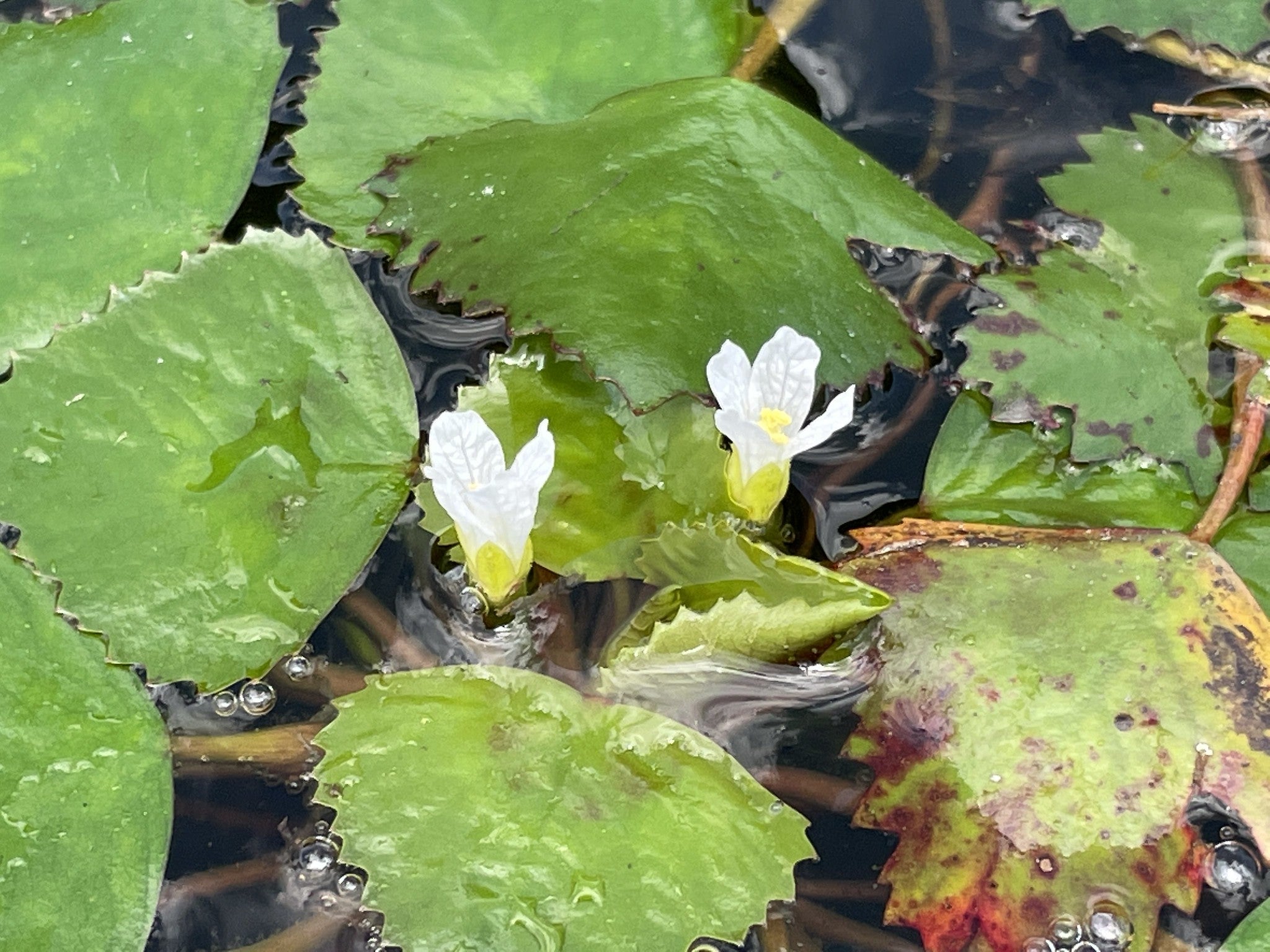
Water Chestnut (Trapa natans), also known as water caltrop, is an aquatic plant with a notable presence in various parts of the world, including India. This plant thrives in slow-moving, shallow waters such as ponds, lakes, and marshes, making it well-suited for wetland areas. It is recognized for its floating rosettes of green leaves and distinctive horned fruit, which contain a single, large edible seed.
The cultivation of Water Chestnut is appreciated not only for its environmental benefits, such as water purification and habitat provision for aquatic life but also for its economic importance. The seeds of the Water Chestnut are harvested for food, known for their crisp texture and sweet, nutty flavor. These seeds can be eaten raw, boiled, or ground into flour, making them a versatile ingredient in a variety of culinary dishes.
However, while Trapa natans offers several benefits, it's also important to note its potential invasiveness in non-native environments. In places where it has been introduced, it can form dense mats that hinder water flow, affect native aquatic species, and impact recreational activities. Management and control measures may be necessary to prevent its spread in such areas.
In India, the Water Chestnut is not only valued as a food source but also holds cultural significance, often used in fasting dishes during religious festivals. Its cultivation and harvest are typically done manually, making it a labor-intensive but economically viable crop for many rural communities.
In terms of care, Water Chestnut plants prefer sunny locations and can be grown from seeds or tubers. They require a growing season of at least 5-7 months of warm weather to produce fruit. Planting is usually done in the late spring, with harvest occurring in the late summer or early fall, depending on the local climate.
Despite its advantages, potential growers should research local regulations and environmental considerations before introducing Water Chestnut to non-native areas, to ensure it contributes positively to the local ecosystem and biodiversity.
20. Willow Trees (Salix spp.)

Willow Trees (Salix spp.) are among the most adaptable and easy-to-grow trees, renowned for their elegant beauty and incredible resilience, particularly in wet environments. With over 400 species, willows offer a variety of sizes and forms, from majestic trees to low-growing shrubs, making them versatile choices for landscape designs.
Characteristics: Willows are easily recognized by their slender, graceful branches and elongated leaves, often with a silver or bluish hue that dances beautifully in the wind. Many species produce catkins—fluffy, flower-like structures—in early spring before the leaves appear, adding early interest to gardens.
Habitat: Preferring moist soil conditions, willows are ideal for planting near water bodies like rivers, ponds, and lakes. They play a crucial role in natural ecosystems by stabilizing soil and preventing erosion. Their love for water makes them perfect for wet areas in gardens or landscapes prone to waterlogging.
Care: Willows are hardy and require minimal care once established. They grow best in full sun to partial shade and thrive in a variety of soil types, as long as the soil is moist. Regular pruning helps maintain their shape and encourages healthy growth. However, some species can be aggressive growers, so it’s important to choose the right type for your space and manage their growth accordingly.
Uses: Beyond their aesthetic appeal, willows have practical uses. Their wood is flexible and strong, traditionally used in basketry and furniture making. Some species, like the White Willow (Salix alba), have medicinal properties; the bark contains salicin, a compound similar to aspirin.
Environmental Benefits: Willows play a significant role in environmental conservation. They can be used in phytoremediation projects to clean polluted water, as their roots absorb and filter contaminants. Additionally, willows provide habitat and food for wildlife, including birds, insects, and small mammals.
Choosing a Willow: When selecting a willow tree for your garden or landscape, consider the available space, as some species can grow quite large. Dwarf varieties are available for smaller spaces. Local nurseries and garden centers can offer species best suited to your region’s climate and soil conditions.
In conclusion, willow trees are not just beautiful and elegant additions to the landscape; they are also workhorses that contribute to the health of the environment. Their ease of care, rapid growth, and environmental benefits make them invaluable in both ornamental and practical applications. Whether you are looking to add visual interest, create natural borders, or address soil erosion, willows are a compelling choice.
For acquiring these plants, consider visiting nurseries like Kadiyam Nursery, which specialize in a wide range of plants suitable for different Indian climates and garden needs. Additionally, websites such as Gardening Know How, Missouri Botanical Garden, and Royal Horticultural Society offer extensive information on plant care and suitability for various environments.
When selecting plants for wet areas, consider the specific conditions of your garden, such as water depth, soil type, and sunlight availability, to ensure that your chosen plants thrive and contribute to a beautiful, healthy garden ecosystem.

Leave a comment